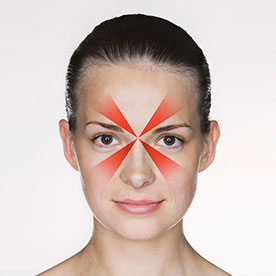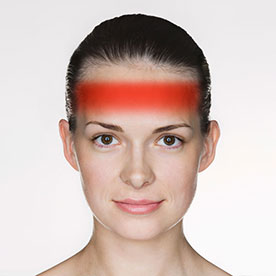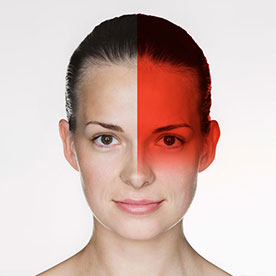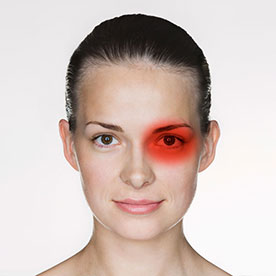The lights are twinkling, the smell of fresh greens is in the air, and red wine flows generously. But this picture-perfect holiday scene can spell disaster for headache sufferers, who may be feeling extra stress as they are confronted with different triggers this time of year. Instead of opening presents, they’re stuck opening that aspirin bottle for relief.
As many as 45 million Americans have chronic severe headaches that can be disabling.1 The condition leads to more than 8 million doctor visits a year.1 It’s important to know what causes a headache, and what type you may have. Since pain or discomfort in the head or face is enough to make any holiday celebration go south, learn more about this common problem so you can avoid it or find relief.
Headache Type




Types of Headache
People experience headaches differently: how often they occur, how intense the pain is, and where the pain is focused.
Tension headaches
Tension headaches are the most common type, says Dr. Andrew M. Blumenfeld, Teladoc Health expert and Director of the Headache Center of Southern California, who explains they aren’t usually disabling. Stress and tight muscles play a role in this dull, mild-to-moderate head pain.
This time of year, stressors are everywhere: from traffic to shopping to visiting extended family. Work and sleep schedules may be out of whack, and you may be consuming more alcohol or food than usual. Extra stress on your mind and body can be a pain in the neck—well, the head and neck.
Migraines
Migraines are more intense headaches that may cause throbbing and environmental sensitivity. These are the most common type that send people for medical help, says Dr. Blumenfeld, since these headaches can last up to three days and include phases of symptoms. About 30 percent of migraine patients first develop auras, visual changes involving an expanding blind spot that may have a zigzag outline with flashing lights, he explains. Migraines can also bring nausea, vomiting, or lightheadedness.3
Dr. Blumenfeld says migraines can be diagnosed by evaluating these symptoms:
- headache that involves one side of the head,
- pain that is throbbing and interfering with your ability to function,
- pain that is aggravated by head movement such as coughing, sneezing, or bending over,
- nausea/vomiting, and
- sensitivity to both light and noise, possibly with aura.
Cluster headaches
Cluster headaches happen in a series that may last weeks or months, and bring a severe pain usually on one side of the head, usually behind one eye.3 There may be redness, swelling, and extra moisture, as well as runny nose or forehead swelling.
Both cluster headaches and migraine headaches can be confused with sinus-related problems, Dr. Blumenfeld points says. “Many patients attribute their headaches to sinusitis or allergies, but sinus infection is actually a rare cause of headache.”
Preventing and Easing the Pain
Exercise, weight loss, stress management, and diet are all important in controlling how often you get headaches, Dr. Blumenfeld says. Holiday partygoers typically indulge in sweets, alcohol, caffeine, and processed foods, which may cause difficulties for certain headache sufferers. Nearly 20 percent of migraine sufferers say food triggers—such as aged cheese, wine, dark beers, cashews, onions, chocolate, processed meats, food additives, wheat, and dairy—are causes for their pain.2 Avoid trigger foods and focus on a healthy, whole-food diet. Consider eating a snack of fruits and vegetables before you head to that holiday happy hour.
It’s is a myth that caffeine is good for headaches, reports Dr. Blumenfeld. “Caffeine intake should be limited to less than 200 mg a day—about a single cup of coffee—to prevent caffeine withdrawal headaches,” he says.
If you’re prone to headache pain, follow doctor recommendations for both exercise and sleep. Healthy adults will benefit from moderate aerobic exercise at least 150 minutes a week, or 75 minutes of vigorous exercise weekly.4 Getting 7 to 9 hours of solid sleep each night often leads to a decrease in migraines.5
While good choices can help manage headaches, medications may still be needed for comfort. Over-the-counter remedies such as aspirin, ibuprofen, and acetaminophen can help with pain. But Dr. Blumenfeld warns not to rely on these too often—never for more than 10 days per month. “Too many days of use…will actually worsen the migraine condition,” he says, adding that prescription medications and injections are available for chronic migraines.
Problem (Not) Solved
While the common types of primary headaches account for about 90 percent of all headaches, 10 percent of them are symptoms of a larger issue and should be ruled out. Examples include headaches due to neck injuries; eye, jaw or teeth problems; brain tumor; stroke or infection. If you’re having headaches often that affect your daily life, consult with a physician about your symptoms and history.
Also get medical care if you have any of these symptoms along with a severe headache:3
- Stiff neck
- Fever
- Nausea
- Vomiting
- Convulsion
- Shortness of breath
- Confusion
- Muscular weakness
- Double vision
- Change in level of consciousness
Thankfully for most of us, headache pain can be managed through a healthy lifestyle, pain relievers, lying down to rest, and reducing stress. This holiday season, remember to be proactive about your health.
If you’re in pain and unsure where to turn, our national network of U.S. board-certified Teladoc doctors is available on demand, 24/7. Our physicians can help resolve routine medical issues from anywhere, at any time. Download our app or sign in now to request a visit so you can enjoy healthier, happier holidays.
Check out more on what you can do for headaches
1http://www.nnadoc.com/html/headache_center.html
2https://www.takingcharge.csh.umn.edu/conditions/migraine
3https://www.cedars-sinai.org/health-library/diseases-and-conditions/h/headache.html
4https://health.gov/paguidelines/second-edition/pdf/PAG_ExecutiveSummary.pdf
5https://www.takingcharge.csh.umn.edu/enhance-your-wellbeing/health/sleep/what-do-experts-recommend-healthy-sleep
image/courtesy University of Mississippi Medical Center, via
https://www.umc.edu/news/Miscellaneous/2018/09/CONSULT%20September%202018/mitigating-migraines.html
This portion of the Teladoc Health website occasionally offers health, fitness and nutritional information and is provided for educational purposes only. You cannot rely on any information provided here as a substitute for or replacement of professional medical advice, diagnosis or treatment. Teladoc Health cannot assure that the information contained on this site always includes the most recent findings or developments with respect to the particular subject matter covered.
If you ever have any concerns or questions about your health, you should always consult with a physician or other healthcare professional. Do not disregard, avoid or delay obtaining medical- or health-related advice from your healthcare professional because of something you may have read on this site. The use of any information provided on this site is solely at your own risk.
If you are in the United States and think you are having a medical or health emergency, call your healthcare professional, or 911, immediately.




